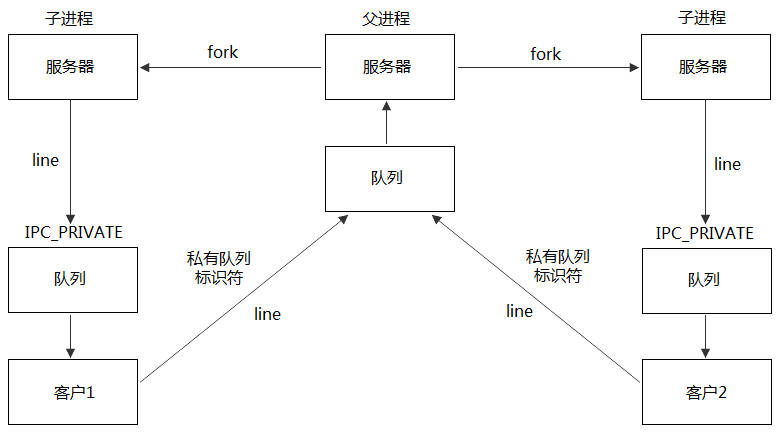linux网络编程之System V 消息队列(二):消息队列实现回射客户/服务器和 msgsnd、msgrcv 函数
一、msgsnd 和 msgrcv 函数
#include <sys/types.h>
#include <sys/ipc.h>
#include <sys/msg.h>
功能:把一条消息添加到消息队列中
原型 int msgsnd(int msqid, const void *msgp, size_t msgsz, int msgflg);
参数
msgid: 由msgget函数返回的消息队列标识码
msgp:是一个指针,指针指向准备发送的消息结构体
msgsz:是msgp指向的消息长度,这个长度不含保存消息类型的那个long int长整型
msgflg:控制着当前消息队列满或到达系统上限时将要发生的事情
返回值:成功返回0;失败返回-1
msgflg=IPC_NOWAIT表示队列满不等待,返回EAGAIN错误。为0表示阻塞等待
消息结构在两方面受到制约。首先,它的具体数据必须小于系统规定的上限值MSGMAX;其次,它必须以一个long int长整数开始,接收者函数将利用这个长整数确定消息的类型。
消息结构参考形式如下:
struct msgbuf {
long mtype;
char mtext[1];
};
The mtext field is an array (or other structure) whose size is specified by msgsz, a nonnegative integer value.Messages of zero length (i.e., no mtext field) are permitted.
即mtex 这块区域可以是个数组或者结构体,大小由参数msgsz 指明。
功能:是从一个消息队列接收消息
原型 ssize_t msgrcv(int msqid, void *msgp, size_t msgsz, long msgtyp, int msgflg);
参数
msgid: 由msgget函数返回的消息队列标识码
msgp:是一个指针,指针指向准备接收的消息结构体
msgsz:是msgp指向的最大消息长度,这个长度不含保存消息类型的那个long int长整型
msgtype:它可以实现接收优先级的简单形式
msgflg:控制着队列中没有相应类型的消息可供接收时将要发生的事
返回值:成功返回实际放到接收缓冲区里去的字符个数,失败返回-1
msgtype=0返回队列第一条信息
msgtype>0返回队列第一条类型等于msgtype的消息
msgtype<0返回队列第一条类型小于等于msgtype绝对值的消息,并且是满足条件的消息类型最小的消息
msgflg=IPC_NOWAIT,队列没有可读消息不等待,返回ENOMSG错误。
msgflg=MSG_NOERROR,消息大小超过msgsz时被截断
msgtype>0且msgflg=MSG_EXCEPT,接收类型不等于msgtype的第一条消息。
二、消息队列实现回射客户/服务器
在前面的系列文章中,我们都是使用socket 套接字来实现回射客户/服务器程序,现在尝试使用消息队列来实现,主要就是利用上面介绍的两个函数msgsnd,msgrcv 。
对于服务器端来说,接收到一个消息结构体的类型如果为1,表示是客户请求,而mtex 字段的前4个字节存放着不同进程的pid ,后续字节才是真正的数据,服务器回射客户端时,将pid 作为类型,mtex 为实际数据,客户端只接收对应类型的数据,故可以区分不同客户端。
程序如下:
echoser.c
|
1
2 3 4 5 6 7 8 9 10 11 12 13 14 15 16 17 18 19 20 21 22 23 24 25 26 27 28 29 30 31 32 33 34 35 36 37 38 39 40 41 42 43 44 45 46 47 48 49 50 51 52 |
#include<stdlib.h>
#include<sys/ipc.h> #include<sys/msg.h> #include<sys/types.h> #include<unistd.h> #include<errno.h> #include<string.h> #define ERR_EXIT(m) \ do { \ perror(m); \ exit(EXIT_FAILURE); \ } while(0) #define MSGMAX 8192 struct msgbuf { long mtype; char mtext[MSGMAX]; }; void echo_ser(int msgid) { struct msgbuf msg; memset(&msg, 0, sizeof(msg)); int nrcv = 0; while (1) { if ((nrcv = msgrcv(msgid, &msg, MSGMAX, 1, 0)) < 0); int pid = *((int *)msg.mtext); fputs(msg.mtext + 4, stdout); msg.mtype = pid; msgsnd(msgid, &msg, nrcv, 0); memset(&msg, 0, sizeof(msg)); } } int main(int argc, char *argv[]) { int msgid; msgid = msgget(1234, IPC_CREAT | 0666); if (msgid == -1) ERR_EXIT("msgget"); echo_ser(msgid); return 0; } |
echocli.c
|
1
2 3 4 5 6 7 8 9 10 11 12 13 14 15 16 17 18 19 20 21 22 23 24 25 26 27 28 29 30 31 32 33 34 35 36 37 38 39 40 41 42 43 44 45 46 47 48 49 50 51 52 53 54 55 56 57 58 |
#include<stdio.h>
#include<stdlib.h> #include<sys/ipc.h> #include<sys/msg.h> #include<sys/types.h> #include<unistd.h> #include<errno.h> #include<string.h> #define ERR_EXIT(m) \ do { \ perror(m); \ exit(EXIT_FAILURE); \ } while(0) #define MSGMAX 8192 struct msgbuf { long mtype; char mtext[MSGMAX]; }; void echo_cli(int msgid) { int nrcv; int pid = getpid(); struct msgbuf msg; memset(&msg, 0, sizeof(msg)); msg.mtype = 1; *((int *)msg.mtext) = pid; while (fgets(msg.mtext + 4, MSGMAX, stdin) != NULL) { if (msgsnd(msgid, &msg, 4 + strlen(msg.mtext + 4), IPC_NOWAIT) < 0) ERR_EXIT("msgsnd"); memset(msg.mtext + 4, 0, MSGMAX - 4); if ((nrcv = msgrcv(msgid, &msg, MSGMAX, pid, 0)) < 0) ERR_EXIT("msgsnd"); fputs(msg.mtext + 4, stdout); memset(msg.mtext + 4, 0, MSGMAX - 4); } } int main(int argc, char *argv[]) { int msgid; msgid = msgget(1234, 0); if (msgid == -1) ERR_EXIT("msgget"); echo_cli(msgid); return 0; } |
程序逻辑不复杂,就不多说了,编译运行服务器端,再开两个客户端,可以看到正常回射输出。
但上述程序是存在死锁的风险的,当开了多个客户端,将队列写满了,此时服务器端想要写入就会阻塞,而因为客户端一旦发送了数据就阻塞等待服务器端回射类型为pid的消息,即队列的消息不会减少,此时就会形成死锁,即使服务器端是非阻塞地写入,此时会返回EAGAIN 的错误,程序逻辑来说我们也会使其不断地尝试去写入,而不是粗暴地将其退出进程,这样还是会死锁。
对此问题可以多开几个私有的队列进行服务,如下:
即某个客户端先创建一个私有消息队列,然后将私有消息队列标识符和具体数据发到共享的队列,服务器fork 出一个子进程,此时根据私有队列标识符就可以将数据回射到这个队列,这个客户端就可以从私有队列读取到回射的数据。
参考:
《UNP》
新一代开源开发者平台 GitCode,通过集成代码托管服务、代码仓库以及可信赖的开源组件库,让开发者可以在云端进行代码托管和开发。旨在为数千万中国开发者提供一个无缝且高效的云端环境,以支持学习、使用和贡献开源项目。
更多推荐
 已为社区贡献15条内容
已为社区贡献15条内容










所有评论(0)